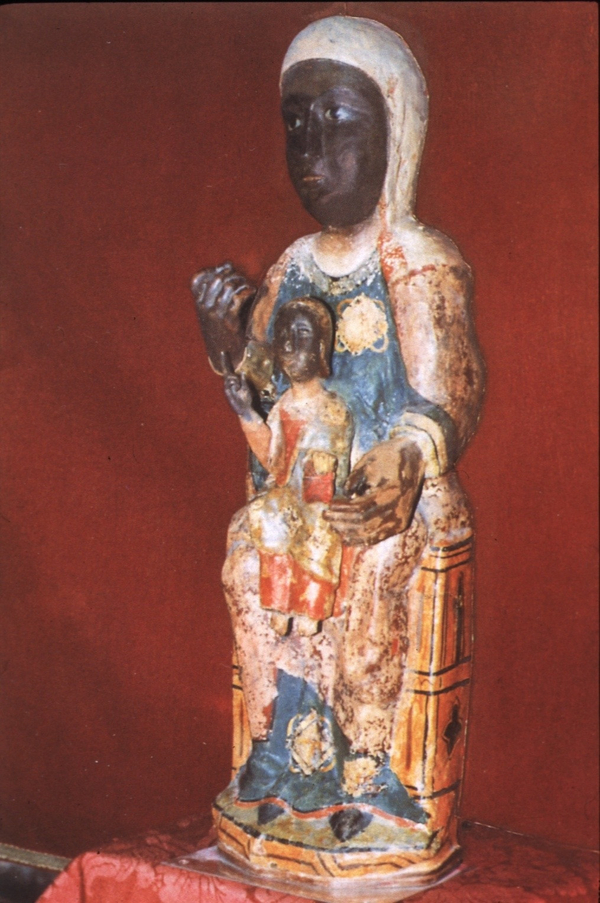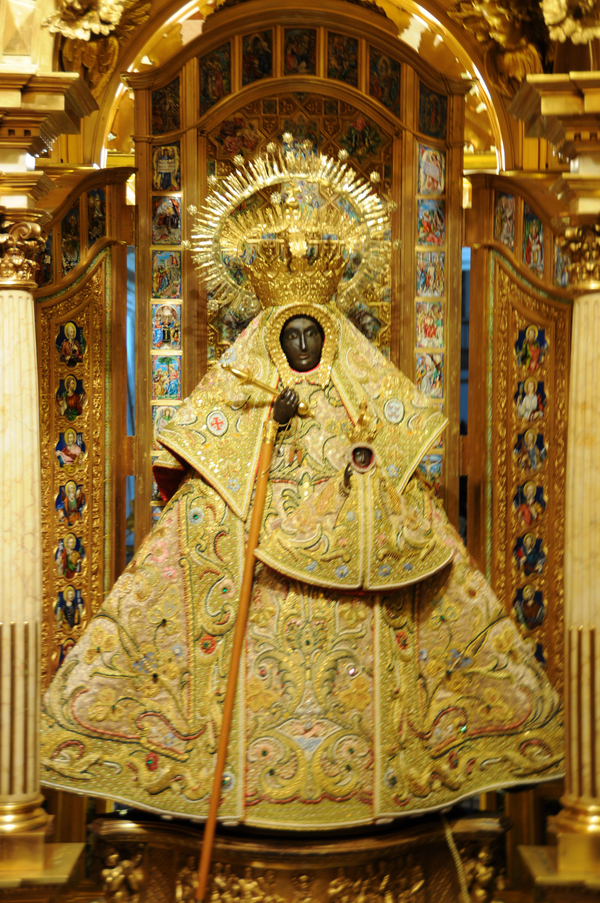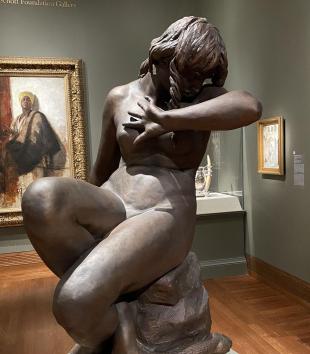The Spanish Virgin of Guadalupe venerated in the monastery of Guadalupe, Extremadura, defies easy categorization. This Marian icon cannot be characterized as a single object as the perception of her authenticity, from which she gains her numinous power, draws on two distinct representations, one nested inside the other. The original effigy, a Romanesque black Madonna, is almost completely occluded by her pyramidal robes (Figs. 1, 2). How the devotee experiences this venerable effigy is profoundly embedded in her various material aspects. Both dressed and undressed figures are crucial to Guadalupe’s miraculous legend and thus her sacrality. My brief narrative will explore the (literally) layered history of this doubling. The play between the wooden, darkened core and the more familiar clothed devotional image, provide a fascinating excursion into the controlled viewing practices of liturgical theater as well as the theological dilemma, acute in a post-Tridentine period, of disengaging matter from the divine prototype it represents.
Stripped of her ornate shell, the titular Virgin of Guadalupe is a surprisingly diminutive sculpture just over two feet in height (59 cm) but growing another foot once dressed and on her pedestal. The polychromed cedar sculpture is of an enthroned Madonna with the Christ Child. The icon assumes its rightful hieratic composition and theological function when the Christ child is seated frontally on his mother’s lap, conforming to a genre referred to as the Throne of Wisdom (sedes sapientiae), that disseminated outward from Northern Europe between the eleventh and thirteenth centuries.1 The Virgin of Guadalupe belongs to a large corpus of Black Madonnas,2 although the symbolic and racial valences of her blackness cannot be addressed here.3
The Extremaduran Mary is also one of the many imágenes de vestir (dressed images) that populated the Iberian peninsula. Since at least 1389, the first dated inventory of her wardrobe, the wooden figures have been encased in lavishly embroidered vestments, allowing only their faces and hands to appear.4 The underlying sculpture has remained essentially unknown and rarely published.5
The ambiguity surrounding Guadalupe’s appearance is already evident in the object’s foundational legend. There is documentary evidence of an active shrine early in the fourteenth century, but her legend, first recorded over a century later, is deftly grafted onto early church history.6 Our Lady of Guadalupe is said to be the same miracle-working icon sculpted by St. Luke and cherished by Pope Gregory I (540-604). Her proven efficacy in ending an epidemic in Rome made “this image” an appropriate gift for San Leandro, bishop of Seville, Spain. The Muslim invasion forced evacuation of the Guadalupe image to Extremadura where she was buried in a cave for safekeeping, only to be discovered 600 years later by a humble shepherd. Of interest is how the devotional object shifts over time in the Guadalupe chronicles from a generic “image” or sculpture (1400-40) to a figure found in her subterranean tomb in pristine vestments of velvet.7 As the legend evolves, the opulently dressed Guadalupe is granted the same originary status as St. Luke’s carved sculpture.
The new primacy given the majestic robes of the Virgin can be better understood as exemplifying Guadalupe’s new historic status. The icon reputedly offered supernatural aid in the Christian reconquest of the Iberian peninsula from the “infidels,” forging close ties between the Jeronymite monastery of Guadalupe and the crown. The royal prerogatives granted by the Catholic Monarchs, Isabel (ca. 1474-1504) and Ferdinand, and subsequent Hapsburg rulers, converted Guadalupe’s monastic complex into one of the wealthiest ecclesiastical establishments of its day.8 Thus, the fashionable robes of this Queen of Heaven, often stitched in gold thread and embedded with precious jewels, communicated her success and evinced the beneficence of its patrons.9 In addition, costly fabrics hid an older, decidedly less splendid form. Archaism, while an asset in supporting a miraculous legend dated back to the primitive church, became an aesthetic embarrassment in an era of extravagantly clothed Marian images.
Layers of fabric also shielded the Virgin of Guadalupe, as she was located in a curtained tabernacle high on the main altarpiece; the public’s sight of her image was carefully orchestrated, revealing and concealing the icon at certain moments during Mass. Moreover, the process of changing her robes and mantles was as guarded as her liturgical viewing was restricted. One “hidden staircase” allowed access to her10 and strictest protocol governed the few who could dress and undress the “Celestial Princess.” In 1631, fray Diego de Montalvo explains that these precautions were in order “to keep in check the bad manners of the many men who …want to see and know everything,” adding that “no one has tried to see what is inside [the clothing] nor the workmanship of her body, nor the materials of which she is made; all of this because of the great reverence of those who touch her. No one knows anything about her with certainty nor have they seen whether she is one single sculpture nor even if she is seated or standing.”11 It is telling that the word used for undressing (desnudando) emphasizes the improper removal of clothing to the naked state, no matter that the wooden sculpture was fully clothed.12 These prescriptions in the handling of Guadalupe, like other devotional images, reveal an acute awareness of the precarious divide between representation and presence. Her dressing and undressing, processing, hiding, and revealing, confer an animation on the sculpture, even if dependent on human assistance. In this the Virgin of Guadalupe becomes more than a conduit for expressing divine power and moves into the dangerous terrain of possessing divine power.
Whether sequestered within her architectural shell or hidden beneath layers of costly fabrics, Guadalupe was protected and concealed as part of the staging of her hierophany. This attitude about the sacra is well articulated by the influential Bishop of Bologna, Gabriele Paleotti when he wrote that sacred objects should be hidden behind a cloth or a crystal pane so as not to too readily disclose the “secrets of God.”13 Like a saint’s relic encased in an elaborate reliquary, aspects of the Guadalupe icon were off limits, beyond normal sight and comprehension, in order to ensure that her charisma remained intact.
Notes
Notes
1. Ilene Forsyth, The Throne of Wisdom: Wood Sculptures of the Madonna in Romanesque France (Princeton, NJ: Princeton University Press, 1972).
2. Numbers of dark and black images of the Virgin Mary from the medieval and early modern periods are variously estimated. Ean Begg, Las Vírgenes Negras (Barcelona: Martinez Roca, 1987), 16, 151-248.
3. Jeanette Favrot Peterson, Visualizing Guadalupe From Black Madonna to Queen of the Americas (Austin: University of Texas Press, in press), chapter 1.
4. Diego de Ecija, Libro de la invención de esta Santa Imagen de Guadalupe y de la erección y fundación de este monasterio (Cáceres: Departmento Provincial de Seminarios de F.E.T. y de las J.O.N.S, 1953), 153-167. The Jeronymite Ecija wrote the core of his history around 1514, however, the 1953 publication is based on a copy of his work dated to 1560 and contains posthumous material.
5. Sebastián García Rodríquez, Guadalupe: Siete siglos de fe y de cultura (Guadalupe: Ediciones Guadalupe, 1993), 14.
6. On the earliest documents of 1327 and 1329, see García Rodríguez, Guadalupe, 26. On the Guadalupe legend, see Ecija, Libro de la invención, 37-50.
7. Diego de Montalvo, Venida de la soberana Virgen de Guadalupe a España (Lisbon: Pedro Craesbeeck, 1631), 13v.
8. Jeffrey Schrader, La Virgen de Atocha: Los Austrias y las imágenes milagrosas (Madrid: Ayuntamiento de Madrid, 2006).
9. The Catholic Church censured these practices as worldly, even indecent. On this see Susan Verdi Webster, “Shameless Beauty and Worldly Splendor: On the Spanish Practice of Adorning the Virgin,” in The Miraculous Image in the Late Middle Ages and Renaissance, ed. Erik Thunø and Gerhard Wolf (Rome: L’Erma di Bretschneider, 2004), 249-271. Guadalupe’s splendid wardrobe was defended by the friar-chroniclers, such as Gabriel de Talavera, Historia de Nuestra Señora de Guadalupe (Toledo: Imprenta Tomás de Guzmán, 1597), 186-186v.
10.Talavera, Historia, 160v.
11. Montalvo, Venida, 13v.
12. Richard C. Trexler, Religion in Social Context in Europe and America 1200-1700 (Tempe, Arizona: Arizona Center for Medieval and Renaissance Studies, 2002), 378.
13. Gabriele Paleotti, Discorso intorno alle imagini sacre e profane, 1582, book II chap. 33; quoted in Robert Klein & Henri Zerner, Italian Art 1500-1600, Sources and Documents (Englewood Cliffs, NY: Prentice-Hall, 1966), 126.
Imprint
10.22332/con.obj.2014.22
1. Jeanette Favrot Peterson, "The Virgin of Guadalupe, Extremadura, Spain," Object Narrative, in Conversations: An Online Journal of the Center for the Study of Material and Visual Cultures of Religion (2014), doi:10.22332/con.obj.2014.22
Peterson, Jeanette Favrot. "The Virgin of Guadalupe, Extremadura, Spain." Object Narrative. In Conversations: An Online Journal of the Center for the Study of Material and Visual Cultures of Religion (2014). doi:10.22332/con.obj.2014.22




